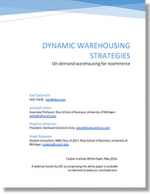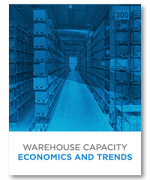Warehouse Capacity Economics and Trends
This paper explores the data and economics behind warehouse capacity and inventory issues, and illustrates how on-demand warehousing can provide a specific, right-sized option when extra space is needed and how to monetize space when it is unused.
For years, firms have driven their supply chains to be stable, predictable structures.
Yet, increasing demands to be more responsive now challenge that approach.
Organizations deal everyday with seasonal swings, return issues, opening new markets and rolling out new products.
Being responsive means addressing the dynamics that cause inventory variability.
Those solutions must be scalable, secure, compliment existing structures and deliver cost efficiencies. Nowhere is this more evident than in the warehouse.
These increased demands are driving the growing practice of On-Demand Warehousing.
On-Demand Warehousing is a spot market companion to the existing “long market” built on warehouse leases and/or property ownership. It is analogous to adding outsourced warehouse labor to an existing team in order to better meet variable demand by matching the capacity deployed to the capacity needed.
This paper is a start for exploring the data and economics behind warehouse capacity and inventory issues.
It has illustrated that these peaks and valleys present meaningful, financially challenging issues. It has also provided a potentially new way of tackling these challenges.
On-Demand Warehousing provides a spot market solution for both sides of the equation.
It doesn’t replace owned facilities, 3PLs or even strategic subleases. But it does provide a specific, right-sized option when extra space is needed and an innovative way to monetize space when it is unused.
Both of those flow to the bottom line and keep the flow of goods manageable, flexible and economical.
While this paper focuses primarily on cost and efficiency benefits of On-Demand Warehousing, it is just the beginning. Revenue, growth and customer satisfaction likely benefit as well.
For example, how can an On-Demand model drive growth by more flexibly enabling the deployment of inventory closer to customers? How can a more flexible approach to warehousing drive increased customer satisfaction?
And for those organizations re-examining their warehouse network, how can the inclusion of On-Demand principles change the fundamental calculus used to determine the number, location and size of warehouses needed to achieve desired balance between market responsiveness and overall cost structure in the era of omnichannel sales and heightened consumer expectations?
What’s Related




Favorites





